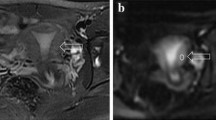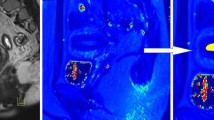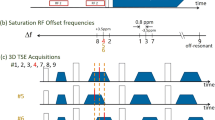Abstract
Purpose
To analyze the effect of changes in the menstrual cycle and age on the signal intensity of amide proton transfer (APT) imaging in normal uterine structures.
Methods
Thirty-one healthy females (age: 21–50 years old) underwent regular pelvic MRI and APT sequences during their menstrual cycle. The APT values of the endometrium, myometrium, and junctional zone were measured. One-way and multi-way analyses of variance were used to analyze the data. Intraindividual difference and Pearson's correlation analyses were also conducted.
Results
The APT values of the uterine structures during the menstrual, proliferative, and secretory phases were 3.413 ± 0.682%, 4.776 ± 0.829%, and 5.218 ± 0.772% for the endometrium; 2.966 ± 0.533%, 3.597 ± 0.380%, and 4.324 ± 0.583% for the myometrium; and 1.703 ± 0.393%, 2.362 ± 0.486%, and 2.779 ± 0.528% for the junctional zone. The individual variation in the APT values of the normal uterus during the three menstrual phases was 1.1–1.7%.There were no significant differences in APT values of uterine structures with age. The APT values of the endometrium were greater than those of other structures (P < 0.05).The Pearson correlation coefficients between APT values of uterine structures and menstrual cycle were 0.686, 0.743, and 0.684, respectively.
Conclusion
The menstrual cycle had a significant effect on the APT signal intensities of the uterine structures, whereas premenopausal age had no significant effect. Changes in the uterine structures during the menstrual cycle should be considered when using APT to diagnose suspected uterine lesions.






Similar content being viewed by others
Abbreviations
- APT:
-
Amide proton transfer
- CEST:
-
Chemical exchange saturation transfer
- VEGF:
-
Vascular endothelial growth factor
- MMP:
-
Matrix metalloproteinases
- ECM:
-
Extracellular matrix
- TIMPs:
-
Tissue inhibitors of metalloproteinases
- LRP-1:
-
Lipoprotein receptor-related protein-1
- SPAIR:
-
Spectral attenuation with inversion recovery
- TSE:
-
Turbo spin echo
References
[1]Forsen S, Hoffman RA(1963) Study of moderately rapid chemical exchange reactions by means of nuclear magnetic double resonance.Chem Phys 39:2892-2901.
[2]Ward KM, Aletras AH, Balaban RS(2000) A new class of contrast agents for MRI based on proton chemical exchange dependent saturation transfer(CEST). J Magn Reson143:79–87. https://doi.org/10.1006/jmre.1999.1956
[3] Zhang J, Zhu W, Tain R, Zhou XJ, Cai K(2018) Improved Differentiation of Low-Grade and High-Grade Gliomas and Detection of Tumor Proliferation Using APT Contrast Fitted from Z-Spectrum. Mol Imaging Biol 20:623-631. https://doi.org/10.1007/s11307-017-1154-y
[4]Jiang S, Eberhart CG, Lim M, et al(2019) Identifying Recurrent Malignant Glioma after Treatment Using Amide Proton Transfer-Weighted MR Imaging: a Validation Study with Image-Guided Stereotactic Biopsy. Clin Cancer Res 25:552-561. https://doi.org/10.1158/1078-0432.CCR-18-1233
[5] Li Y, Lin CY, Qi YF, et al(2021) Non-invasive Differentiation of Endometrial Adenocarcinoma from Benign Lesions in the Uterus by Utilization of Amide Proton Transfer-Weighted MRI. Mol Imaging Biol 23:446-455. https://doi.org/10.1007/s11307-020-01565-x
[6]Takayama Y,Nishie A,Togao O,et al(2018) Amide proton transfer MR imaging of endometrioid endometrial adenocarcinoma:association with histologic grade. Radiology 286:909-917. https://doi.org/10.1148/radiol.2017170349
[7]Zhang S, Sun H, Li B, Wang X, Pan S, Guo Q(2019) Variation of amide proton transfer signal intensity and apparent diffusion coefficient values among phases of the menstrual cycle in the normal uterus: A preliminary study. Magn Reson Imaging 63:21-28. https://doi.org/10.1016/j.mri.2019.07.007
[8] Shitano F, Kido A, Kataoka M, et al(2016) MR appearance of normal uterine endometrium considering menstrual cycle: differentiation with benign and malignant endometrial lesions. Acta Radiol 57:1540-1548. https://doi.org/10.1177/0284185115626478
[9] Maybin JA, Boswell L, Young VJ, Duncan WC, Critchley HOD(2017) Reduced Transforming Growth Factor-β Activity in the Endometrium of Women With Heavy Menstrual Bleeding. J Clin Endocrinol Metab 102:1299-1308. https://doi.org/10.1210/jc.2016-3437
[10] Marshall SA, Senadheera SN, Parry LJ, Girling JE(2017) The Role of Relaxin in Normal and Abnormal Uterine Function During the Menstrual Cycle and Early Pregnancy. Reprod Sci 24:342-354. https://doi.org/10.1177/1933719116657189
[11] Smith SK(2001) Regulation of angiogenesis in the endometrium. Trends Endocrinol Metab 12:147-151. https://doi.org/10.1016/s1043-2760(01)00379-4
[12]Sugino N, Kashida S, Karube-Harada A, Takiguchi S, Kato H(2002) Expression of vascular endothelial growth factor (VEGF) and its receptors in human endometrium throughout the menstrual cycle and in early pregnancy. Reproduction 123:379-387. https://doi.org/10.1530/rep.0.1230379
[13]Charnock-Jones DS, Macpherson AM, Archer DF, et al(2000) The effect of progestins on vascular endothelial growth factor, oestrogen receptor and progesterone receptor immunoreactivity and endothelial cell density in human endometrium. HumReprod 15:85-95. https://doi.org/10.1093/humrep/15.suppl_3.85
[14] Shifren JL, Tseng JF, Zaloudek CJ, et al(1996) Ovarian steroid regulation of vascular endothelial growth factor in the human endometrium: implications for angiogenesis during the menstrual cycle and in the pathogenesis of endometriosis. J Clin Endocrinol Metab 81:3112-3118. https://doi.org/10.1210/jcem.81.8.8768883
[15] Zhang J, Salamonsen LA(2002). In vivo evidence for active matrix metalloproteinases in human endometrium supports their role in tissue breakdown at menstruation. J Clin Endocrinol Metab 87:2346-2351 https://doi.org/10.1210/jcem.87.5.8487
[16] Jabbour HN, Kelly RW, Fraser HM, Critchley HO(2006) Endocrine regulation of menstruation. Endocr Rev 27:17-46. https://doi.org/10.1210/er.2004-0021
[17] Selvais C, Gaide Chevronnay HP, Lemoine P, et al(2009) Metalloproteinase-dependent shedding of low-density lipoprotein receptor-related protein-1 ectodomain decreases endocytic clearance of endometrial matrix metalloproteinase-2 and -9 at menstruation. Endocrinology 150:3792-3799. https://doi.org/10.1210/en.2009-0015
[18] Yu H, Lou H, Zou T, et al(2017) Applying protein-based amide proton transfer MR imaging to distinguish solitary brain metastases from glioblastoma. Eur Radiol 27:4516-4524. https://doi.org/10.1007/s00330-017-4867-z
[19] Vogelstein B, Lane D, Levine AJ(2000) Surfing the p53 network. Nature 408:307-310. https://doi.org/10.1038/35042675
[20]Suzuki A, Kariya M, Matsumura N, et al(2012) Expression of p53 and p21(WAF-1), apoptosis, and proliferation of smooth muscle cells in normal myometrium during the menstrual cycle: implication of DNA damage and repair for leiomyoma development. Med Mol Morphol 45:214-221. https://doi.org/10.1007/s00795-011-0562-3
[21] He YL, Ding N, Li Y, et al(2016) Cyclic changes of the junctional zone on 3 T MRI images in young and middle-aged females during the menstrual cycle. Clin Radiol 71:341-348. https://doi.org/10.1016/j.crad.2015.12.005
[22]Scoutt LM, Flynn SD, Luthringer DJ, McCauley TR, McCarthy SM(1991) Junctional zone of the uterus: correlation of MR imaging and histologic examination of hysterectomy specimens. Radiology 179:403-407. https://doi.org/10.1148/radiology.179.2.2014282
[23]He YL, Li Y, Lin CY, et al(2019) Three-dimensional turbo-spin-echo amide proton transfer-weighted mri for cervical cancer: A preliminary study. J Magn Reson Imaging 50:1318-1325. https://doi.org/10.1002/jmri.26710
[24]Ohno Y, Yui M, Koyama H, et al(2016) Chemical Exchange Saturation Transfer MR Imaging: Preliminary Results for Differentiation of Malignant and Benign Thoracic Lesions. Radiology279:578-589. https://doi.org/10.1148/radiol.2015151161
[25] Caserta MP, Bolan C, Clingan MJ(2016) Through thick and thin: a pictorial review of the endometrium. Abdom Radiol (NY) 41:2312-2329. https://doi.org/10.1007/s00261-016-0930-5
[26] Well D, Yang H, Houseni M, et al(2007) Age-related structural and metabolic changes in the pelvic reproductive end organs. Semin Nucl Med 37:173 -184. https://doi.org/10.1053/j.semnuclmed.2007.01.004
Acknowledgements
We thank the Kai Deng PH.D, Medical Ethics Committee of Shandong Provincial Qianfoshan Hospital, relevant MRI staff and researchers at Philips Healthcare for supporting this study.
Funding
The authors did not receive support from any organization for the submitted work.
Author information
Authors and Affiliations
Contributions
All authors contributed to the study conception and design. XC, YK, and QQ: Methodology, YK and QQ: Formal analysis and investigation, YK and all authors Writing—original draft preparation, KD: Writing—review and editing, KD, LM, and ZW: Supervision.
Corresponding author
Ethics declarations
Conflicts of interest
The authors have no competing interests to declare that are relevant to the content of this article.
Research involving human and animals rights
All procedures performed in studies involving human participants were in accordance with the ethical standards of the institutional and/or national research committee and with the 1964 Helsinki Declaration and its later amendments or comparable ethical standards. The study was approved by the Medical Ethics Committee of Shandong Provincial Qianfoshan Hospital.
Informed consent
Informed consent was obtained from all individual participants included in the study. The authors affirm that human research participants provided informed consent for publication of the images in Figs. 2, 3, 4.
Additional information
Publisher's Note
Springer Nature remains neutral with regard to jurisdictional claims in published maps and institutional affiliations.
Rights and permissions
Springer Nature or its licensor holds exclusive rights to this article under a publishing agreement with the author(s) or other rightsholder(s); author self-archiving of the accepted manuscript version of this article is solely governed by the terms of such publishing agreement and applicable law.
About this article
Cite this article
Kong, Yq., Qu, Qq., Ming, L. et al. Effect of changes in the menstrual cycle and age on the signal intensity of amide proton transfer imaging in the normal uterus: a preliminary study. Abdom Radiol 47, 4219–4226 (2022). https://doi.org/10.1007/s00261-022-03674-3
Received:
Revised:
Accepted:
Published:
Issue Date:
DOI: https://doi.org/10.1007/s00261-022-03674-3




